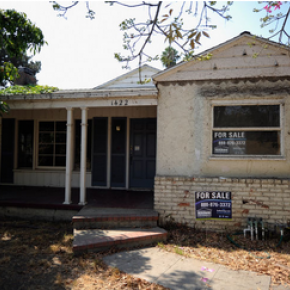Letter: Gorsuch wrong for Supreme Court
As a faith leader deeply involved in the lives of working people, I understand the impact that the nation’s highest court can have on our daily lives. We need a Supreme Court Justice committed to...
As a faith leader deeply involved in the lives of working people, I understand the impact that the nation’s highest court can have on our daily lives. We need a Supreme Court Justice committed to protecting the rights of all people. The more I learn about Neil Gorsuch, confirmed by the Senate on Friday, the more convinced I am that he is not that justice...
Read full article here.
Latinos Have The Highest Mortality Rate In Accidents Of The New York Construction Industry
Latinos Post - February 26, 2014, by Jorge Calvillo - The Hispanic and immigrant population employed in the construction industry in the state of New York is the ethnic group most vulnerable to...
Latinos Post - February 26, 2014, by Jorge Calvillo - The Hispanic and immigrant population employed in the construction industry in the state of New York is the ethnic group most vulnerable to fatal accidents in the workplace, according to a report by the Center for Popular Democracy.
According to El Diario NY, the data collected by the study shows that between 2003 and 2011, within the total amount of deaths by falls and accidents in construction areas registered in New York City, 60 percent of the deceased were Hispanic and/or immigrants.
This is an alarming figure because 75 construction workers die due to accidents per year in the state of New York, revealed journalist Blanca Rosa Vílchez, for news network Univisión.
The source points out that in New York, 41 percent of construction workers are Hispanic. However, the report released on Thursday showed that 74 percent of the deaths by accidents belong to that same ethnic group.
Last September 24, construction workers in Brooklyn protested to demand better safety conditions in their workplaces, after they reported a significant rise in accidents related to the low investment in safety that companies offer, which has caused severe accidents which in many cases have taken the lives of workers, who receive a minimum salary.
Back then, El Diario NY reported that the workers protested at 227 Carlton Avenue in Fort Greene, where a 62-year-old worker lost his life when the roof of one of the buildings he was working on collapsed onto him on September 10.
According to the protestors, contractor companies in New York buy low-quality materials to save some money and don't invest in safety courses for their workers, which leaves construction workers in a perilous situation.
The Latino community working in the construction industry is double vulnerable in this situation, since many of the workers are undocumented immigrants, and if they suffer an accident, they don't report the construction company for fear of being deported or fired.
As if this were not enough, if violations of safety norms are reported, the fines against construction companies are very low, which makes it easy for them to continue ignoring safety norms in construction sites.
Univisión highlights that the fines construction companies face are no higher than $2,000 in case of an accident, and $12,000 if a worker dies, a figure that reflects the dimensions of the risks that construction workers must face every day.
Source
Groups demand recovery money for Puerto Rico
The Center for Popular Democracy and Make the Road CT plan to deliver postcards at the Bridgeport office of U.S. Rep. Jim Himes, D-4, demanding Congress "have a heart" and send an aid package to...
The Center for Popular Democracy and Make the Road CT plan to deliver postcards at the Bridgeport office of U.S. Rep. Jim Himes, D-4, demanding Congress "have a heart" and send an aid package to Puerto Rico with no additional oversight or austerity measures.
"The efforts also preview a larger mobilization on the 6-month anniversary of Hurricane Maria, when hundreds of activists from across the country will travel to Washington, D.C. to demand a comprehensive aid package for Puerto Rico that does not impose more austerity, oversight or privatization," said Julio López Varona, a spokesman for the group.
Read the full article here.
"You Can Save My Life": Traveling on Same Plane, Man With ALS Confronts Sen. Flake Over GOP Tax Bill

"You Can Save My Life": Traveling on Same Plane, Man With ALS Confronts Sen. Flake Over GOP Tax Bill
Sen. Jeff Flake (R-Ariz.) boarded a plane leaving Washington, D.C. on Thursday, less than a week after voting for a tax bill that could result in devastating cuts to disability programs.
...
Sen. Jeff Flake (R-Ariz.) boarded a plane leaving Washington, D.C. on Thursday, less than a week after voting for a tax bill that could result in devastating cuts to disability programs.
Ady Barkan, a 33-year-old father living with amyotrophic lateral sclerosis (ALS), boarded the same flight after spending several days protesting the very legislation Flake helped ram through the Senate.
Read the full article here.
Top Fed Officials Meet Protesters on Sidelines of Jackson Hole
Federal Reserve Vice Chairman Stanley Fischer and 10 of his colleagues met Thursday with a coalition of activists to hear complaints about the U.S. central bank, in a first-of-its-kind event on...
Federal Reserve Vice Chairman Stanley Fischer and 10 of his colleagues met Thursday with a coalition of activists to hear complaints about the U.S. central bank, in a first-of-its-kind event on the sidelines of an annual policy retreat in Jackson Hole, Wyoming.
“Even when we disagree, we do it with mutual respect.,” said Esther George, president of the Kansas City Federal Reserve, who hosts the high-powered symposium in the heart of the Grand Teton National Park that draws central bankers from all over the world. “We are pleased to have this conversation.”
Esther George speaks with Shawn Sebastian, field director of the pro-worker Fed Up coalition, an initiative of the Center for Popular Democracy, following a meeting with a coalition of activists on the sidelines of the Jackson Hole economic symposium on Aug. 25.
Esther George speaks with Shawn Sebastian, field director of the pro-worker Fed Up coalition, an initiative of the Center for Popular Democracy, following a meeting with a coalition of activists on the sidelines of the Jackson Hole economic symposium on Aug. 25. Photographer: David Paul Morris/Bloomberg
Faced with criticism that it doesn’t look out for the interests of poorer Americans that have been sharpened in this U.S. presidential election year, the Fed has been going out of its way to show that it’s getting the message.
Fischer and George were joined by New York Fed chief William Dudley, Boston’s Eric Rosengren, Cleveland’s Loretta Mester, Neel Kashkari from Minneapolis, Governor Lael Brainard, the Atlanta Fed’s Dennis Lockhart, Robert Kaplan from Dallas, John Williams from San Francisco, and Richmond Fed boss Jeffrey Lacker.
The pro-worker Fed Up coalition, an initiative of the Center for Popular Democracy, is pressing for more diversity among the leadership of the central bank and for policies that take into account the needs of low and middle income families. Several speakers explicitly urged the Fed not to raise interest rates to fight a threat of inflation that they didn’t believe was real.
Got to Go
Fed Up protesters wearing green T-shirts chanted “Hey hey, ho ho, these Wall Street banks, they’ve got to go” at a rally prior to the meeting at the Jackson Lake Lodge, where the symposium will hear a speech Friday from Chair Janet Yellen.
Dudley said that the Fed had done a “pretty lousy” job of delivering better diversity and added that “I want to look at all changes people are suggesting.”
Fed Up says the central bank is dominated by white men -- Yellen is its first woman chair -- and takes issue with the fact that private banks select two-thirds of the members of the 12 regional banks’ boards of directors.
The Richmond Fed responded to those complaints this week -- economic writer Helen Fessenden and economist Gary Richardson on Tuesday published an economic brief addressing Fed Up’s concerns, and they say monetary policy isn’t well-suited to the end goal the activists have in mind.
By Steve Matthews & Jeff Black
Source
As Atlanta Fed President Retires, Some Call For Diversity

As Atlanta Fed President Retires, Some Call For Diversity
The Federal Reserve has received a lot of criticism recently for its lack of diversity. The leaders of the central banking system are almost all white men.
But now that the president of one...
The Federal Reserve has received a lot of criticism recently for its lack of diversity. The leaders of the central banking system are almost all white men.
But now that the president of one of the Fed’s 12 regional banks in Atlanta is stepping down, some see an opportunity for change.
Several congressional lawmakers and the activist group Fed Up are calling on the agency to appoint the system’s first black president at the Federal Reserve Bank of Atlanta.
“The fed is the nerve center of our entire economic system, and nobody is suffering from an economic depression as the African-American community,” Congressman David Scott said.
The Georgia Democrat co-wrote a letter, along with Reps. John Lewis, Maxine Waters and John Conyers, to Federal Reserve Chair Janet Yellen on the issue.
Black workers still struggle, Scott said, even as the overall economy has recovered. The jobless rate for African Americans, for example, is more than double their white neighbors.
Outside an unemployment office on the west side of Atlanta, Formosa Williams is at her wit’s end.
“At this point, I don’t know what to do,” Williams said.
For years, Williams said she has struggled to find stable work.
“The only jobs that really seem to be hiring are like fast food,” Williams said. “And it’s no way I’m going to go back to that.”
Scott and the activists hope stories of minority workers, like Williams, will take a more prominent place in the central banking system’s discussions once it has a black regional president.
“Unless you have a voice at that table that has gone through the experience of being an African American, you’re missing so much,” said Scott.
The congressman and activists argue the appointment also makes sense, given the region the bank covers -- the South -- and that region’s history with civil rights.
But while many economists might agree that diversity is good, they aren’t all sure how it translates into policy.
“I think you have to start out with the recognition that our Federal Reserve officials have really one tool, and that’s interest rates,” said Tim Duy, an economics professor at the University of Oregon. “That tool is a very blunt instrument.”
That tool affects the broader economy at a macro-level, said Duy, who also authors a blog called Fed Watch. Meanwhile, he said, many of the problems facing African-American workers are at the micro-economic level.
“The Federal Reserve is not going to be a silver bullet to these issues,” Duy said.
The search for the next Atlanta Fed president is being led by a committee of business leaders from around the South.
The chair, Thomas Fanning, who is president of Southern Company, said they’re looking for the best person most of all.
And if he or she happens to make history, as the first African American?
“That would be a great thing,” Fanning said.
By STEPHANNIE STOKES
Source
Housing advocates accuse Wells Fargo of damaging communities through foreclosures
89.3KPCC - March 13, 2013 - Wells Fargo writes the most mortgages in California. According to a ...
89.3KPCC - March 13, 2013 - Wells Fargo writes the most mortgages in California. According to a new report released Tuesday from a consortium of grassroots activists and housing advocates, 11,616 of those loans are currently in foreclosure, out of roughly 65,000 homes in foreclosure in the state.
The report accuses Wells Fargo of damaging both California communities and the state’s overall economy. It was produced by the Alliance of Californians for Community Empowerment, the Center for Popular Democracy, and the Home Defenders League.
Ross Rhodes of the Alliance of Californians for Community Development said on a conference call Tuesday that Wells Fargo was singled out because the bank is "responsible for handling more delinquent loans than any other servicer."
He added that Wells Fargo is failing to live up to the terms of last year's mortgage settlement between the states and the country's biggest banks. Rhodes said that Wells is lagging behind both Bank of America and Chase in efforts to keep people in their homes.
In a statement, Wells Fargo said that its foreclosure rate in California is lower than its rate in the nation as a whole and that the report "appears to be an attempt to question Wells Fargo’s longstanding track record as a fair and responsible lender and servicer."
The bank emerged from the financial crisis relatively unscathed. But in recent years it has been called to task for past lending practices. It was was fined $175 million by the Justice Department in 2012 for steering minorities into costly subprime loans before the housing crisis.
The bank was also fined $148 million by the Securities and Exchange Commission for violations perpetrated by Wachovia Securities (Wells took control of Wachovia in 2008, at the height of crisis, when major U.S. banks were failing).
The report also argues that Wells Fargo’s foreclosures in the state are disproportionately affecting African American and Latino neighborhoods and could wind up costing the state $20 million in lost tax revenue.
The authors say that the solution is “principal reduction” — adjusting mortgages to reflect the reduced market value of homes in foreclosure.
Numerous economists support the idea of principal reduction, but the notion has been resisted at the federal level, most notably by Edward DeMarco, acting director of the Federal Housing Finance Agency, which has overseen mortgage giants Fannie Mae and Freddie Mac since they were taken into receivership during the financial crisis.
DeMarco has supported principal forbearance, a method that would not reduce the amount of mortgages held by Fannie and Freddie but rather restructure them so that homeowners could see more affordable payments.
The report's consortium of advocates doesn't favor forbearance, arguing that it can't address the core issue of borrowers drowing in debt.
But as tempting as principal reduction might be in theory, in practice is doesn't always lead to the homeowner staying in the home.
Economist Stuart Gabriel is Director of the Ziman Center for Real Estate at UCLA. He said that principal reduction isn't a "cure all."
"For borrowers that are deeply underwater, a modest amount of principal reduction is going to make no difference the ultimate outcome, which would be default and foreclosure," Gabriel said.
In its statement, Wells Fargo called its principal reduction efforts since 2009 "aggressive." But the advocacy groups said that Wells Fargo is one of the most difficult banks to work with, and that it engages in "dual tracking" — undertaking loan modifications at the same time it moves forward with the foreclosure process.
The report also recommends that Wells Fargo disclose more data about its foreclosures, and specifically about the impact that foreclosures are having on minority neighborhoods in California.
Gabriel said that more transparency about lending practices and the racial and geographical makeup of loan portfolios is always a good thing because additional information improves markets.
Source
2 Women Who Confronted Jeff Flake About Kavanaugh Vote in an Elevator Credited for 1 Week Delay

2 Women Who Confronted Jeff Flake About Kavanaugh Vote in an Elevator Credited for 1 Week Delay
Before Sen. Jeff Flake reversed his guarantee of a “yes” vote for Brett Kavanaugh and demanded an FBI investigation into the allegations, he was confronted by two women who said they were...
Before Sen. Jeff Flake reversed his guarantee of a “yes” vote for Brett Kavanaugh and demanded an FBI investigation into the allegations, he was confronted by two women who said they were survivors of sexual assault.
“Don’t look away from me. Look at me and tell me that it doesn’t matter what happened to me, that you will let people like that go into the highest court of the land and tell everyone what they can do to their bodies,” Maria Gallagher angrily told Flake.
Gallagher, 23, was accompanied by activist Ana Maria Archila, who broke through a group of reporters to speak with him in an elevator.
Read the full article here.
The Tip of the Iceberg: Charter School Vulnerabilities To Waste, Fraud, And Abuse
The Tip of the Iceberg: Charter School Vulnerabilities To Waste, Fraud, And Abuse
Escalating Fraud Warrants Immediate Federal and State Action to Protect Public...
The Tip of the Iceberg: Charter School Vulnerabilities To Waste, Fraud, And AbuseEscalating Fraud Warrants Immediate Federal and State Action to Protect Public Dollars and Prevent Financial MismanagementDownload the report hereApril 2015Executive SummaryA year ago, the Center for Popular Democracy (CPD) issued a report demonstrating that charter schools in 15 states—about one-third of the states with charter schools—had experienced over $100 million in reported fraud, waste, abuse, and mismanagement. This report offers further evidence that the money we know has been misused is just the tip of the iceberg. Over the past 12 months, millions of dollars of new alleged and confirmed financial fraud, waste, abuse, and mismanagement in charter schools have come to light, bringing the new total to over $200 million.Despite the tremendous ongoing investment of public dollars to charter schools, government at all levels has failed to implement systems that proactively monitor charter schools for fraud, waste, abuse, and mismanagement. While charter schools are subject to significant reporting requirements by various public offices (including federal monitors, chartering entities, county superintendents, and state controllers and auditors), very few public offices regularly monitor for fraud.The number of instances of serious fraud uncovered by whistleblowers, reporters, and investigations suggests that the fraud problem extends well beyond the cases we know about. According to standard forensic auditing methodologies, the deficiencies in charter oversight throughout the country suggest that federal, state, and local governments stand to lose more than $1.4 billion in 2015.b 1 The vast majority of the fraud perpetrated by charter officials will go undetected because the federal government, the states, and local charter authorizers lack the oversight necessary to detect the fraud.Setting up systems that detect and deter charter school fraud is critical. Investments in strong oversight systems will almost certainly offset the necessary costs. We recommend the following reforms:
Mandate audits that are specifically designed to detect and prevent fraud, and increase the transparency and accountability of charter school operators and managers. Clear planning-based public investments to ensure that any expansions of charter school investments ensure equity, transparency, and accountability. Increased transparency and accountability to ensure that charter schools provide the information necessary for state agencies to detect and prevent fraud.State and federal lawmakers should act now to put systems in place to prevent fraud, waste, abuse and mismanagement. While the majority of state legislative sessions are coming to an end, there is an opportunity to address the charter school fraud problem on a federal level by including strong oversight requirements in the Elementary and Secondary Education Act (ESEA), which is currently being debated in Congress. Unfortunately, some ESEA proposals do very little reduce the vulnerabilities that exist in the current law. If the Act is passed without the inclusion of the reforms outlined in this report, taxpayers stand to lose millions more dollars to charter school fraud, waste, abuse, and mismanagement.Download the report here
This Is Exactly How HIV Activists Disrupted Congress to Save Health Care

This Is Exactly How HIV Activists Disrupted Congress to Save Health Care
Late last month, thousands of Americans with HIV/AIDS -- many of them among the millions of Americans who rely on Medicaid or Affordable Care Act (ACA) plans for their health coverage -- saw the...
Late last month, thousands of Americans with HIV/AIDS -- many of them among the millions of Americans who rely on Medicaid or Affordable Care Act (ACA) plans for their health coverage -- saw the news and breathed yet one more major sigh of relief: GOP Senate leader Mitch McConnell announced that, lacking the votes needed to win, the Senate would not go forward on its final effort this year to kill the ACA (aka Obamacare) and take a devastating bite out of Medicaid.
Read the full article here.









4 days ago
4 days ago